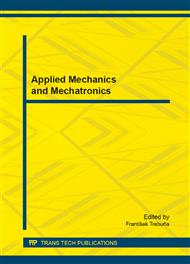[1]
M. Puškár, P. Bigoš, Method for accurate measurements of detonations in motorbike high speed racing engine, Measurement 45 (3) (2012) 529–534.
DOI: 10.1016/j.measurement.2011.10.014
Google Scholar
[2]
M. Puškár, P. Bigoš, P. Puškárová, Accurate measurements of output characteristics and detonations of motorbike high-speed racing engine and their optimization at actual atmospheric conditions and combusted mixture composition, Measurement 45 (5) (2012).
DOI: 10.1016/j.measurement.2012.01.036
Google Scholar
[3]
M. Puškár, P. Bigoš, Measuring of acoustic wave influences generated at various configurations of racing engine inlet and exhaust system on brake mean effective pressure, Measurement 46 (9) (2013) 3389– 3400. ISSN 0263-2241.
DOI: 10.1016/j.measurement.2013.05.008
Google Scholar
[4]
R. Nosek, J. Jandačka, M. Holubčík, Effect of temperature of the combustion air on the emission parameters of burning biomass, in: 7th global conference on power control and optimization, Prague, Czech Republic, 25–26 August (2013).
Google Scholar
[5]
S. Gaspar, J. Pasko, Influence of technological factors of die casting on mechanical properties of castings from silumin, Lect. Notes Electr. Eng. 240 (2013) 713–722. ISSN 1876-1100.
DOI: 10.1007/978-94-007-6738-6_88
Google Scholar
[6]
B. Buľko, J. Kijac, T. Borovský, The influence of chemical composition of steel on steel desulphurisation, Archives of Metallurgy and Materials. Vol. 56, no. 3, pp.605-609, ISSN 1733-3490.
DOI: 10.2478/v10172-011-0065-1
Google Scholar
[7]
J. Danko, M. Bugár, V. Staňák, Energy analysis of hybrid power source during vehicle motion, Scientific Proceedings Faculty of Mechanical Engineering STU Bratislava. Vol. 19/2011, s. 37-42, ISSN 1338-1954, ISSN 1338-5011.
DOI: 10.2478/v10228-011-0006-z
Google Scholar
[8]
J. Danko, T. Milesich, M. Bugár, J. Madarás, Characteristic model of a shock absorber in an unmanned ground vehicle. In: Scientific Proceedings Faculty of Mechanical Engineering STU Bratislava. ISSN 1338-1954 Vol. 20/2012, 2012, pp.37-43.
DOI: 10.2478/v10228-012-0008-5
Google Scholar
[9]
E. Nedeliaková, M. Babin, D. Barta, Rationalization of static transport [Racionalizácia statickej dopravy], Transport and the environment (Vol. 2), proceedings of the 9th SoNorA University Think Tank Conference (Bologna). 19th of October 2011, s. 15-33, ISSN 1868-8411.
Google Scholar


